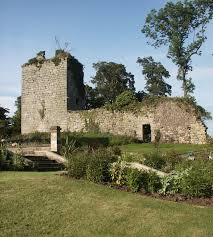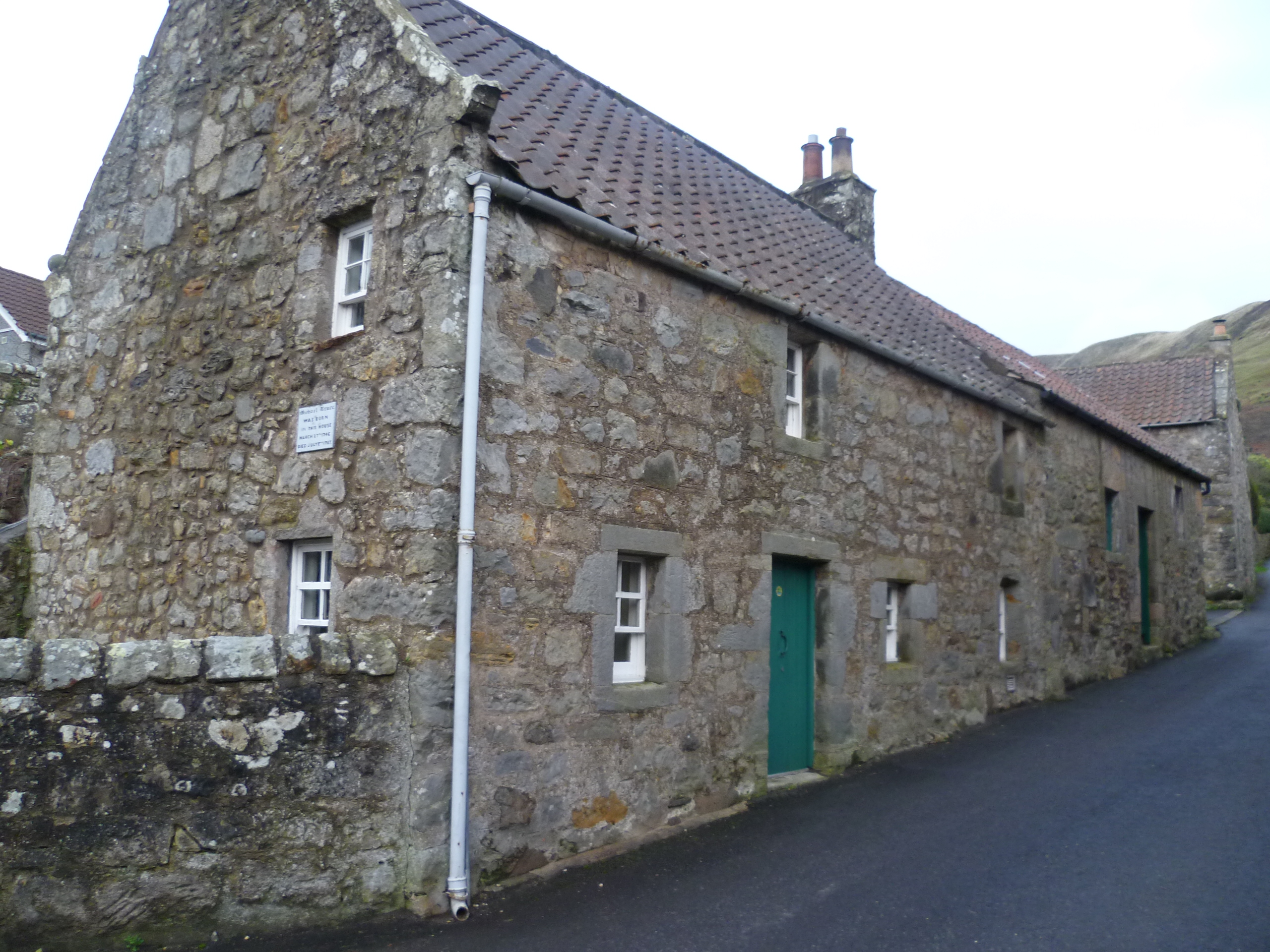|
Arnot Tower
Arnot Tower is a ruined 16th-century castle located in the grounds of Arnot Tower House, less than from Scotlandwell, Perth and Kinross, Scotland. The current building dates from c. 1507, though fortifications were present c. 1400. The castle has four storeys and a vaulted basement. It was built by the Arnot family who have records dating back to 1105. David Arnot of Fyfe (Fife) was one of 2000 noble landowners required to swear allegiance to King Edward I of England in 1296. Nicol Arnot Arnot was a loyal supporter of King Robert the Bruce. Robert Arnot was killed in the battle of Flodden in 1514. The Arnots abandoned the old tower around 1700. The castle is a scheduled monument. In 1760 local poet Michael Bruce wrote a poem about the true story of a love affair between an Arnot daughter and a Balfour of nearby Burleigh Castle The remains of Burleigh Castle are located just outside the village of Milnathort, 1.5 miles north of Kinross, in Perth and Kinross, Scotland. The ... [...More Info...] [...Related Items...] OR: [Wikipedia] [Google] [Baidu] |
Scotlandwell
Scotlandwell is a village in Portmoak, Kinross-shire, Scotland. It is within the Perth and Kinross council area. It lies to the east of Loch Leven, at the junction of the A977 and B920 roads, approximately west of Glenrothes and east of Kinross. Scotlandwell is one of the historic sites of Kinross-shire. Named Fons Scotiae by the Romans who founded it nearly 2,000 years ago, the curative waters that bubble up through the sandy ground were used by Red Friars who maintained a hospital in the village between 1250 and 1587. Thousands of pilgrims came to Scotlandwell to take the water, the most famous perhaps being King Robert the Bruce who is alleged to have found a cure for leprosy here. The two main historical features of Scotlandwell village are the Well and Wash House. The Well and Wash House The building of the ornamental well and wash house in Scotlandwell in more recent times was undertaken as part of a general scheme of village improvement carried out between 1857 ... [...More Info...] [...Related Items...] OR: [Wikipedia] [Google] [Baidu] |
Perth And Kinross
Perth and Kinross ( sco, Pairth an Kinross; gd, Peairt agus Ceann Rois) is one of the 32 council areas of Scotland and a Lieutenancy Area. It borders onto the Aberdeenshire, Angus, Argyll and Bute, Clackmannanshire, Dundee, Fife, Highland and Stirling council areas. Perth is the administrative centre. With the exception of a large area of south-western Perthshire, the council area mostly corresponds to the historic counties of Perthshire and Kinross-shire. Perthshire and Kinross-shire shared a joint county council from 1929 until 1975. The area formed a single local government district in 1975 within the Tayside region under the ''Local Government (Scotland) Act 1973'', and was then reconstituted as a unitary authority (with a minor boundary adjustment) in 1996 by the ''Local Government etc. (Scotland) Act 1994''. Geographically the area is split by the Highland Boundary Fault into a more mountainous northern part and a flatter southern part. The northern area is a popular to ... [...More Info...] [...Related Items...] OR: [Wikipedia] [Google] [Baidu] |
Edward I Of England
Edward I (17/18 June 1239 – 7 July 1307), also known as Edward Longshanks and the Hammer of the Scots, was King of England and Lord of Ireland from 1272 to 1307. Concurrently, he ruled the duchies of Aquitaine and Gascony as a vassal of the French king. Before his accession to the throne, he was commonly referred to as the Lord Edward. The eldest son of Henry III, Edward was involved from an early age in the political intrigues of his father's reign, which included a rebellion by the English barons. In 1259, he briefly sided with a baronial reform movement, supporting the Provisions of Oxford. After reconciliation with his father, however, he remained loyal throughout the subsequent armed conflict, known as the Second Barons' War. After the Battle of Lewes, Edward was held hostage by the rebellious barons, but escaped after a few months and defeated the baronial leader Simon de Montfort at the Battle of Evesham in 1265. Within two years the rebellion was extin ... [...More Info...] [...Related Items...] OR: [Wikipedia] [Google] [Baidu] |
Robert The Bruce
Robert I (11 July 1274 – 7 June 1329), popularly known as Robert the Bruce (Scottish Gaelic: ''Raibeart an Bruis''), was King of Scots from 1306 to his death in 1329. One of the most renowned warriors of his generation, Robert eventually led Scotland during the First War of Scottish Independence against England. He fought successfully during his reign to regain Scotland's place as an independent kingdom and is now revered in Scotland as a national hero. Robert was a fourth great-grandson of King David I, and his grandfather, Robert de Brus, 5th Lord of Annandale, was one of the claimants to the Scottish throne during the "Great Cause". As Earl of Carrick, Robert the Bruce supported his family's claim to the Scottish throne and took part in William Wallace's revolt against Edward I of England. Appointed in 1298 as a Guardian of Scotland alongside his chief rival for the throne, John Comyn of Badenoch, and William Lamberton, Bishop of St Andrews, Robert resigned in 13 ... [...More Info...] [...Related Items...] OR: [Wikipedia] [Google] [Baidu] |
Battle Of Flodden
The Battle of Flodden, Flodden Field, or occasionally Branxton, (Brainston Moor) was a battle fought on 9 September 1513 during the War of the League of Cambrai between the Kingdom of England and the Kingdom of Scotland, resulting in an English victory. The battle was fought near Branxton, Northumberland, Branxton in the county of Northumberland in northern England, between an invading Scots army under King James IV of Scotland, James IV and an English army commanded by the Thomas Howard, 2nd Duke of Norfolk, Earl of Surrey. In terms of troop numbers, it was the largest battle fought between the two kingdoms."The Seventy Greatest Battles of All Time". Published by Thames & Hudson Ltd. 2005. Edited by Jeremy Black. Pages 95 to 97.. After besieging and capturing several English border castles, James encamped his invading army on a commanding hilltop position at Flodden and awaited the English force which had been sent against him, declining a challenge to fight in an open field. Su ... [...More Info...] [...Related Items...] OR: [Wikipedia] [Google] [Baidu] |
Scheduled Monument
In the United Kingdom, a scheduled monument is a nationally important archaeological site or historic building, given protection against unauthorised change. The various pieces of legislation that legally protect heritage assets from damage and destruction are grouped under the term "designation." The protection provided to scheduled monuments is given under the Ancient Monuments and Archaeological Areas Act 1979, which is a different law from that used for listed buildings (which fall within the town and country planning system). A heritage asset is a part of the historic environment that is valued because of its historic, archaeological, architectural or artistic interest. Only some of these are judged to be important enough to have extra legal protection through designation. There are about 20,000 scheduled monuments in England representing about 37,000 heritage assets. Of the tens of thousands of scheduled monuments in the UK, most are inconspicuous archaeological sites, but ... [...More Info...] [...Related Items...] OR: [Wikipedia] [Google] [Baidu] |
Michael Bruce (poet)
Michael Bruce (27 March 1746 – 5 July 1767) was a Scottish poet and hymnist. Early life Bruce was born at Kinnesswood in the parish of Portmoak, Kinross-shire. His father, Alexander Bruce, was a weaver. Michael was taught to read before he was four years old, and one of his favourite books was a copy of Sir David Lyndsay's works. His attendance at school was often interrupted, because he had to herd cattle on the Lomond Hills in summer, and this early companionship with nature greatly influenced his poetry. A delicate child, he grew up as the pet of his family and friends. He studied Latin and Greek, and at fifteen, when his schooling was completed, a small legacy left to his mother, with some additions from kindly neighbours, enabled him to go to the University of Edinburgh, which he attended during the four winter sessions 1762–1765. Adult life In 1765 he taught during the summer months at Gairney Bridge, receiving about 5/- a year in fees and free board in a ... [...More Info...] [...Related Items...] OR: [Wikipedia] [Google] [Baidu] |
Burleigh Castle
The remains of Burleigh Castle are located just outside the village of Milnathort, 1.5 miles north of Kinross, in Perth and Kinross, Scotland. The castle dates from the 15th and 16th centuries, and now sits beside the A911 road, opposite a 19th-century steading, recently adapted into housing. History The lands of Burleigh were held by the Balfours from 1456, when they were granted by James II to John Balfour of Balgarvie, and a tower house was erected in the late 15th or early 16th century. Sir James Balfour of Pittendreich extended the castle in the late 16th century, adding a curtain wall with a corner tower, and other outbuildings. The castle was a convenient stopping place, Mary of Guise came to dinner at Burleigh on 9 January 1540 and went on to Falkland Palace. James VI of Scotland was a frequent visitor in the time of his son, Sir Michael Balfour. James VI was at Burleigh in January 1589 after spending Christmas at Kinneil House. In July 1596 he stayed at Burleigh then ... [...More Info...] [...Related Items...] OR: [Wikipedia] [Google] [Baidu] |
Castles In Perth And Kinross
A castle is a type of fortified structure built during the Middle Ages predominantly by the nobility or royalty and by military orders. Scholars debate the scope of the word ''castle'', but usually consider it to be the private fortified residence of a lord or noble. This is distinct from a palace, which is not fortified; from a fortress, which was not always a residence for royalty or nobility; from a ''pleasance'' which was a walled-in residence for nobility, but not adequately fortified; and from a fortified settlement, which was a public defence – though there are many similarities among these types of construction. Use of the term has varied over time and has also been applied to structures such as hill forts and 19th-20th century homes built to resemble castles. Over the approximately 900 years when genuine castles were built, they took on a great many forms with many different features, although some, such as curtain walls, arrowslits, and portcullises, were ... [...More Info...] [...Related Items...] OR: [Wikipedia] [Google] [Baidu] |







